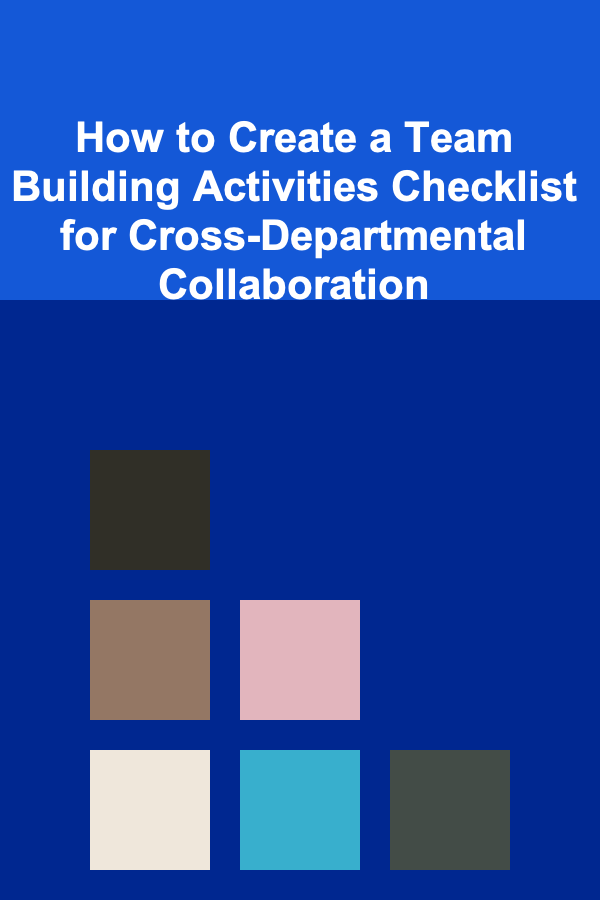
How to Create a Team Building Activities Checklist for Cross-Departmental Collaboration
ebook include PDF & Audio bundle (Micro Guide)
$12.99$5.99
Limited Time Offer! Order within the next:

Building a culture of collaboration between different departments is crucial for organizational success. Cross-departmental collaboration fosters creativity, breaks down silos, and improves overall workflow and productivity. However, creating an environment where teams from different departments work seamlessly together can be challenging without the right approach.
One of the most effective ways to encourage collaboration across departments is through team-building activities. These activities help break down barriers, foster trust, and encourage open communication, all of which are essential for collaboration. But the key is to select the right activities that align with the goals of the organization and the specific needs of the teams involved.
In this actionable guide, we'll explore how to create a comprehensive checklist for team-building activities designed to enhance cross-departmental collaboration. Whether you're a manager or an HR professional tasked with fostering collaboration, this guide will provide you with the tools to design activities that bring teams together.
Step 1: Define Your Objectives for Cross-Departmental Collaboration
Before selecting team-building activities, it's essential to understand what you want to achieve. Different cross-departmental activities will serve different purposes, and aligning these activities with specific organizational goals will ensure they are effective.
Key Objectives to Consider:
- Fostering Better Communication: Effective communication is crucial for collaboration. Team-building activities that focus on improving communication skills can help bridge gaps between departments.
- Building Trust: Trust is a fundamental element of any successful collaboration. Activities that encourage vulnerability and cooperation can help build trust between team members from different departments.
- Encouraging Creativity and Innovation: Cross-departmental activities can spark creative thinking and encourage teams to approach problems from different perspectives, leading to innovative solutions.
- Improving Problem-Solving Skills: Activities that simulate challenges or problem-solving scenarios can help teams learn how to approach complex issues together.
- Breaking Down Silos: By creating opportunities for informal interactions, team-building activities can help break down the barriers between departments and encourage collaboration on a day-to-day basis.
Actionable Checklist Item:
- Identify the key objectives you wish to achieve with your cross-departmental team-building activities.
Step 2: Assess the Needs and Dynamics of the Teams
Every team has its own unique culture, strengths, and challenges. To ensure that the activities are well-suited to the teams involved, it's important to assess their current dynamics. Consider factors such as team size, communication styles, and any existing challenges in collaboration.
Key Factors to Assess:
- Team Size: Larger teams may require activities that break them into smaller groups to encourage participation and engagement, while smaller teams may benefit from more intimate, one-on-one activities.
- Communication Styles: If some teams struggle with communication, choose activities that promote clear and effective dialogue.
- Pre-existing Relationships: If team members already have strong relationships, focus on activities that further strengthen trust or innovation. If there are divisions or a lack of rapport, opt for activities that foster interaction and encourage openness.
- Department-Specific Roles: Ensure that the activities take into account the different roles and responsibilities of each department, as this will help avoid making anyone feel excluded or undervalued.
Actionable Checklist Item:
- Assess the current team dynamics and identify areas that need improvement (e.g., communication, trust, problem-solving).
Step 3: Select a Variety of Activities
When planning team-building activities, variety is key. Different types of activities will target different objectives, and rotating activities will keep things fresh and engaging. Consider a mix of physical, mental, and social activities to appeal to a wide range of team members.
Types of Team-Building Activities:
-
Icebreaker Activities:
- Two Truths and a Lie: A fun, informal game that helps team members get to know each other better.
- Speed Networking: This activity helps team members from different departments interact and learn about each other's roles in a short amount of time.
-
Collaboration-Focused Activities:
- Escape Rooms: Encourages teams to work together to solve problems and think critically under pressure.
- Group Problem-Solving Challenges: Create scenarios where teams need to collaborate to solve a problem, mimicking real-world challenges the departments face.
-
Creative Activities:
- Brainstorming Sessions: Facilitating cross-departmental brainstorming sessions can help generate innovative ideas while also improving communication.
- Collaborative Workshops: Workshops that encourage team members to share their knowledge and skills to achieve a common goal.
-
Physical or Outdoor Activities:
- Team Sports or Challenges: Activities like volleyball, relay races, or scavenger hunts encourage teamwork in a fun, physical environment.
- Outdoor Team-Building Exercises: These could include activities like trust falls, obstacle courses, or problem-solving games that take place outdoors.
-
Reflection and Feedback Activities:
- Retrospective Meetings: After completing an activity, gather feedback from all departments about what worked, what didn't, and what can be improved for future collaboration.
- Group Discussions: Hold discussions about how the activity relates to the department's real-world projects and the lessons learned.
Actionable Checklist Item:
- Select a diverse set of activities that address various aspects of cross-departmental collaboration (e.g., communication, problem-solving, trust).
Step 4: Plan for Inclusivity and Accessibility
It's important that every team member feels included and valued during team-building activities. Consider any special needs or preferences, including accessibility for people with disabilities, dietary restrictions, or cultural differences.
Key Considerations:
- Physical Accessibility: Ensure that activities are accessible to everyone, including those with mobility challenges.
- Cultural Sensitivity: Be mindful of cultural differences in activities, ensuring that no team member feels uncomfortable or excluded.
- Personal Preferences: Some people may prefer low-energy or mental activities over physical ones, so try to balance your activity selections accordingly.
Actionable Checklist Item:
- Ensure that all selected activities are inclusive and accessible for all team members.
Step 5: Set Clear Expectations and Guidelines
To maximize the impact of team-building activities, it's important to establish clear expectations and guidelines. This will ensure that everyone is on the same page and knows what's expected of them during the activity.
Key Expectations to Communicate:
- Purpose: Clearly explain the objective of the activity and how it ties into cross-departmental collaboration.
- Behavior: Encourage openness, respect, and active participation. Set the tone by modeling positive behaviors.
- Time Commitment: Ensure that all participants know how much time the activity will take and that it doesn't interfere with work priorities.
Actionable Checklist Item:
- Set clear expectations for participation, behavior, and objectives before each activity.
Step 6: Evaluate the Effectiveness of the Activities
After each team-building activity, it's crucial to evaluate how well it achieved its intended outcomes. This allows you to refine your approach for future activities and ensures continuous improvement.
Evaluation Methods:
- Surveys or Feedback Forms: Gather feedback from participants about the activity's effectiveness and their overall experience.
- Post-Activity Discussions: Hold discussions where team members reflect on the activity's impact and how it can improve cross-departmental collaboration.
- Observe Behavioral Changes: Monitor whether the activities have led to improvements in communication, trust, or problem-solving between departments.
Actionable Checklist Item:
- Evaluate the success of each activity and gather feedback to refine future team-building efforts.
Step 7: Repeat and Reinforce Collaboration
Team-building activities should be an ongoing effort, not just a one-time event. Regularly scheduled activities ensure that collaboration becomes ingrained in the culture of the organization.
Strategies for Reinforcement:
- Schedule Regular Team-Building Activities: Set a calendar for quarterly or bi-annual activities to maintain momentum.
- Celebrate Collaborative Wins: Acknowledge and celebrate successful cross-departmental projects to reinforce the benefits of collaboration.
- Encourage Socializing: Encourage informal socializing opportunities to build relationships outside of work.
Actionable Checklist Item:
- Plan for continuous reinforcement of collaboration through ongoing team-building activities.
Conclusion
Creating a team-building checklist for cross-departmental collaboration is a powerful way to enhance teamwork, trust, and communication across your organization. By aligning activities with clear objectives, understanding team dynamics, and selecting a variety of activities that foster collaboration, you can create a workplace culture that encourages innovative thinking and seamless cooperation between departments. This, in turn, leads to better outcomes, more engaged employees, and a stronger organization as a whole.
By following this actionable guide, you can start designing meaningful team-building experiences that not only break down barriers between departments but also cultivate a more inclusive, dynamic, and successful work environment.
Reading More From Our Other Websites
- [Screen Printing Tip 101] How to Optimize Curing Speed and Ink Quality with a Flash Dryer
- [Beachcombing Tip 101] Turning Beachcombing Finds into Art and Home Décor
- [Home Maintenance 101] How to Keep Your Home's Staircase in Good Repair
- [Home Maintenance 101] How to Keep Your Home's Basement Dry and Mold-Free
- [Home Lighting 101] How to Layer Lighting in Your Bedroom for a Relaxing Atmosphere
- [Skydiving Tip 101] The Ultimate Step‑by‑Step Guide to Packing Your Parachute Safely
- [Organization Tip 101] Creative Ideas for Placing Solar Garden Lights to Enhance Your Landscape
- [Home Rental Property 101] How to Navigate Local Landlord-Tenant Laws
- [Home Security 101] How to Secure Your Home Against Seasonal Security Risks
- [Organization Tip 101] How to Create a DIY Equipment Rack for Your Home Gym

How to Add Built-In Storage to Your Home During a Renovation
Read More
How to Designate Zones for Different Sewing Projects
Read More
How to Keep Your Closet Organized with Simple Hacks
Read More
How To Incorporate Retinoids for Skin Renewal: A Comprehensive Guide
Read More
How to Diagnose Common Electrical Panel Problems
Read More
How to Manage Serialized Inventory with an Inventory Management System
Read MoreOther Products

How to Add Built-In Storage to Your Home During a Renovation
Read More
How to Designate Zones for Different Sewing Projects
Read More
How to Keep Your Closet Organized with Simple Hacks
Read More
How To Incorporate Retinoids for Skin Renewal: A Comprehensive Guide
Read More
How to Diagnose Common Electrical Panel Problems
Read More